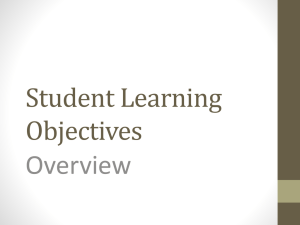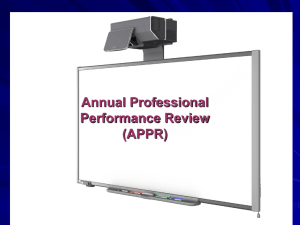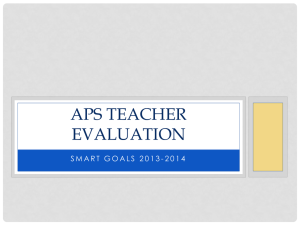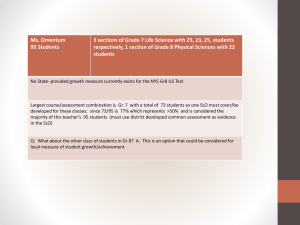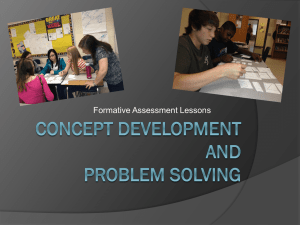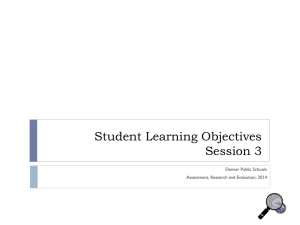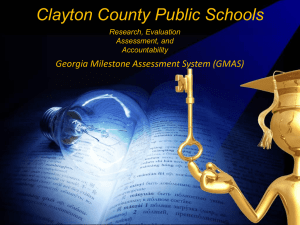Using Data to Inform Growth Targets and Submitting Your SLO
advertisement
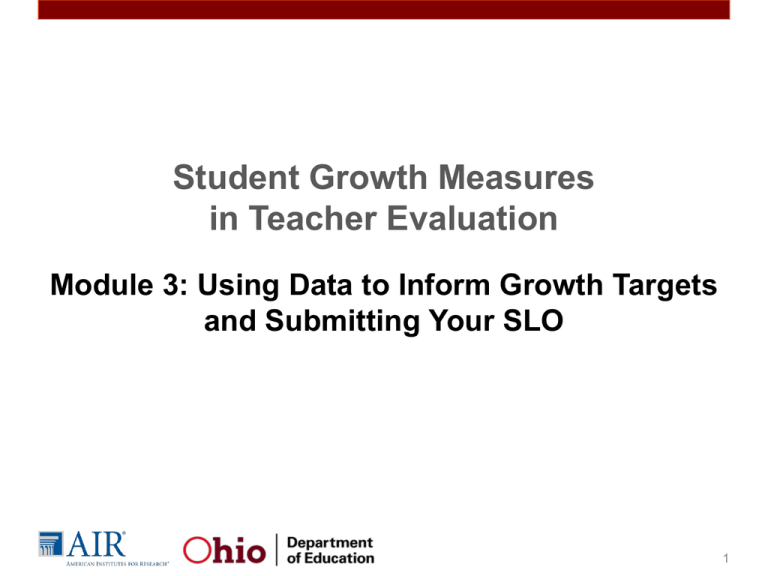
Student Growth Measures in Teacher Evaluation Module 3: Using Data to Inform Growth Targets and Submitting Your SLO 1 Training Norms • • • • • Be present. Actively participate in activities. Respect time boundaries. Recognize the need for quiet while working. Use electronics respectfully and appropriately when prompted. • Return to large group attention when signaled. 2 Agenda • Module 1: Introduction to SLOs • Module 2: Selecting Appropriate Assessments • Module 3: Using Data to Inform Growth Targets and Submitting Your SLO • Module 4: Scoring an Individual SLO 3 The SLO Development Process STEP 1: Gather and review available student data. STEP 2: Determine the interval of instruction and identify content. STEP 3: Choose assessments and set the growth target. STEP 4: Submit your SLO and prepare for approval and review. STEP 5: Final scoring of the SLO. 4 Growth Targets • Should be informed by baseline or, in some cases, trend data. • Should include specific indicators of growth that demonstrate an increase in learning between two points in time. • Should be tiered whenever possible and appropriate. • Should be set so that all students can demonstrate developmentally appropriate growth. 5 Growth Targets • All students must be expected to demonstrate growth. • The expectations captured in growth targets should be rigorous yet attainable. • Growth targets should articulate a specific minimum expected performance. 6 Example Growth Targets Target 1 During the fall semester, all of my students will progress at least one fitness zone on the FitnessGram. 7 Example Growth Targets Target 2 Students will increase their scores by half the difference between 100 and their pre-assessment score. For example, a student with a pre-assessment of 50 would be expected to increase his or her score by 25 points on the post-assessment. 100 – 50 = 50 / 2 = 25 8 Example Growth Targets Target 3 Taking into account student’s entry level of skill, all students will meet their target score on the post assessment: Pre-Assessment Baseline Score Range Target Score on Post-Assessment 41-60 70 61-80 85 81-90 95 plus 85 or higher on capstone project 91-100 95 plus 90 or higher on capstone project 9 Example Growth Targets Target 4 Taking into account student’s entry level of skill, all students will meet their target score on the post assessment: Pre-Assessment Baseline Score Range Target Score on Post-Assessment 41-60 70 or increase score by 15 points, whichever is greater 61-80 85 or increase score by 15 points, whichever is greater 81-90 95 or increase score by 7 points, whichever is greater, plus 85 or higher on capstone project 91-100 97 plus 90 or higher on capstone project 10 Descriptive Growth Target Target 5 Students will improve their performance by meeting the following growth targets using LinguaFolio Can-Do Assessments, supporting data, and a final individualized performance assessment as sources of evidence: Baseline Data (from Spanish I) Growth Target (for Spanish II) Novice Mid Novice High Novice High Intermediate Low Intermediate Low Intermediate Mid 11 How Could This Growth Target Be Improved? Target 6 During the fall semester, 50 percent of the students will earn a National Physical Fitness award for their performance on the Physical Fitness test. This target is focused on proficiency, not growth. It also only requires 50 percent of students to meet the specified goal. Revisions: • Use baseline data to inform the target(s). • Focus on growth, not proficiency. • Consider using a different assessment. 12 How Could This Growth Target Be Improved? Target 7 Students scoring 80 or lower on the pre-assessment will increase their scores on the similar post-assessment by at least 10 points. Any students scoring 81 or higher on the preassessment will maintain their scores. This target could be stronger. It does not sufficiently aim to bring students up to proficiency. Not all students are required to show growth. Revisions: • Consider revising targets if students are very low performing so that all lowperforming students are moving towards proficiency. • Revise targets for students scoring 81 or higher so that they must demonstrate growth. 13 How Could This Growth Target Be Improved? Target 8 Taking into account student’s entry level of skill, all students will meet their target score on the post-assessment: Pre-Assessment Baseline Score Range Target Score Range on Post-Assessment 41-60 65-74 61-80 75-90 81-90 91-100 91-100 95 plus 85 or higher on capstone project The growth target uses tiered targets that are differentiated based upon student baseline data. However, use of ranges does not require ALL students to demonstrate growth. Revisions: • Use minimum expectations (cut scores and/or expected improvement in points) rather than ranges 14 Using Assessment Data to Help Set Appropriate Growth Targets • Use growth goals or targets set by providers (e.g., Scholastic) or the local school district. • Consult with a data, assessment, or content-area expert in your school district who is familiar with the assessment. • Use technical reports from the vendors to see what the expected growth or benchmarks are. • Look at trend data from your past students, provided your classes have a similar composition. 15 An Approach to Setting Growth Targets • Step 1: Determine your baseline data sources (pre-assessment, prior year test scores, etc.) and select a high-quality post-assessment that: – Is aligned to the curriculum – Contains stretch – Is valid and reliable 16 An Approach to Setting Growth Targets • Step 2: Determine performance tiers for the postassessment by establishing score ranges. – What is the passing score? – What score would represent high performance? Example 1 Example 2 Basic (score is <60) Very low achievement (score is <60) Approaching Proficient/Proficient (61-86) Low-mid achievement (61-76) Advanced (87-100) High achievement (87-93) Mid-high achievement (77-86) Exceptional achievement (94-100) 17 An Approach to Setting Growth Targets • Step 3: Determine performance tiers for the baseline data by establishing score ranges. – What is the passing score? – What score would represent high performance? 18 An Approach to Setting Growth Targets • Step 4: Categorize the student performance data on the baseline assessments by the tiers of performance you established in Step 2. Performance Level on Preassessment Number of Students Performing at that Level on the Preassessment Very low achievement (score is <60) 5 Low-mid achievement (61-76) 21 Mid-high achievement (77-86) 12 High achievement (87-93) 11 Exceptional achievement (94-100) 1 19 An Approach to Setting Growth Targets Step 5: Determine what growth expectations are reasonable based upon post-assessment or trend data. Student Student A Student B Student C Student D Student E Pretest Posttest (out of 100) (out of 100) 61 79 63 81 65 82 65 81 66 83 Growth 18 pts 18 pts 17 pts 16 pts 17 pts Mean Growth = (18+18+17+16+17)/5 = 17.5 Median Growth = 17 20 An Approach to Setting Growth Targets 21 An Approach to Setting Growth Targets • Step 6: Set your growth targets based upon the information available to you. Baseline Score (based on preassessment) Very low achievement (score < 60) Low-mid achievement (61-76) Mid-high achievement (77-86) High achievement (87-93) Exceptional achievement (94-100) Number of Students 5 21 12 11 1 Growth Target (for post-assessment; whichever is greater) Score 70 or increase score 15 points Score 81 or increase score by 13 points Score 90 or increase score by 10 points Score 97 plus 80 on capstone project Score 97 or maintain higher score, plus 85 on capstone project 22 Developing Growth Target Activity • Read Handout 3.4. • Work in small groups to set growth targets for Ms. Felipe’s 2012-13 class. Use Handout 3.3 as a guide if needed. • Construct your growth targets in Microsoft Excel using the file on the flash drive OR create targets on chart paper to share. 23 Developing Growth Target Activity • How did your group set the growth targets? • Key takeaways: – Teachers should use the information and data available to them when constructing growth targets. – Conversations with colleagues when setting growth targets can be critical. – The teacher should be able to explain how s/he set the growth targets as well as his or her reasoning for the approach used. – The rationale should include the teacher’s explanation for the growth targets. 24 Requirements and Promising Practices Requirements for Implementing SLOs Minimum of two SLOs representative of the teacher’s schedule for Category C teachers. Promising Practice Recommendations Two to four SLOs representative of the teacher’s schedule for Category C teachers. Gather and use baseline data for each student represented in the SLO. Use the Student Learning Objective Template when writing SLOs. Identify a rigorous and attainable growth target for students. Identify rigorous and attainable tiered targets. Select rigorous and appropriate assessments (not developed by the individual teacher). • • Consult the Guidance on Selecting Assessments when choosing assessments. Complete the Checklist for Selecting Appropriate Assessments. 25 The SLO Development Process STEP 1: Gather and review available student data. STEP 2: Determine the interval of instruction and identify content. STEP 3: Choose assessments and set the growth target. STEP 4: Submit your SLO and prepare for approval and review. STEP 5: Final scoring of the SLO. 26 3-2-1 • On your card, please write the following: – Three ways you anticipate SLOs will impact teacher practice in the classroom – Two takeaways from this training – One area in which you would like additional help or guidance 27 Questions? 28 End of Module 3 • This concludes Module 3: Using Data to Inform Growth Targets and Submitting Your SLO. 29
